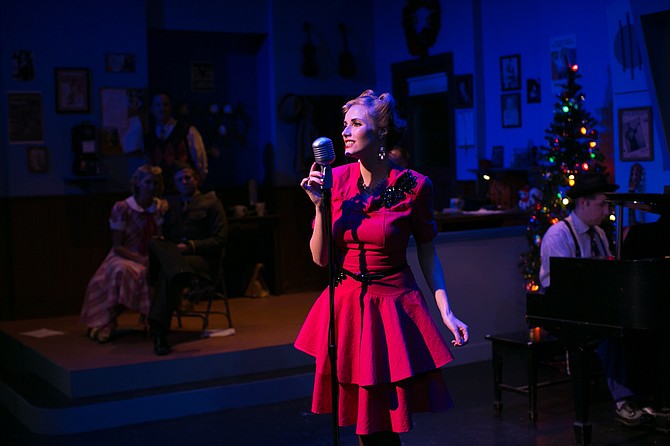 Facebook
Facebook
 X
X
 Instagram
Instagram
 TikTok
TikTok
 Youtube
Youtube

It is December 1942. BJ Gibson, a youthful guy with a killer smile and a beautiful voice, is in love with a singer but soon must go off to war.
Walton Jones’s 1940s Radio Hour is full of music, dancing, and old-time sound effects. Currently at New Village Arts Theatre, the play portrays the final holiday broadcast of the Mutual Manhattan Variety Cavalcade on New York radio station WOV.
Directed by Dana Case, the show has fast pacing with some standout performances. One of the biggest is Zachary Scott Wolfe as BJ.
Another highlight is Michael Kelly as aspiring vocalist Neal Tilden. His singing ability is top-notch, and he is also a gifted comic actor.
Marlene Montes is dazzling as sexy Ginger Brooks and wows the crowd with her rendition of “Blues in the Night.”
Equally impressive as Ann Collier, a featured singer on the broadcast, is Kelly DeRouin, who has the ’40s style mastered. She is particularly wonderful singing “That Old Black Magic” and “Have Yourself a Merry Little Christmas.”
Eric M. Casalini looks every inch the part of the smooth Johnny Cantone, fighting the temptation of the bottle and his ever-crumbling self-esteem. His acting is fine, but his singing lacks the required charisma and romantic style.
Jack Bradford, as the delivery boy eager to go on the air, is perfectly annoying in a charming way, which is exactly right.
Danielle Levas, as Connie Miller, is cute and perky and dances with great style. She is also the choreographer. For a show not chiefly known for its dancing, she has infused some lovely dance numbers that are styling and fun to watch.
Kelly Kissinger is a very believable Pops Bailey, the gruff stage manager with a heart of gold. He is also the set designer, and a bang-up job he as done with the radio-studio set, featuring interesting levels and angles with pleasing blue walls that boast entertainers’ photos from the past.
Chief among some of the curious aspects of this production: changing the part of the womanizing Lou Cohn into a female (played adequately by D. Candis Paule). This makes the part less interesting, and we lose some of the period fun.
Another cast shocker is cutting the part of the torch singer, Geneva. This decision hampers the period believability of the show. Combining the part of Biff Baker (a trumpet player going off to war) with the part of BJ Gibson also lessens the dramatic effect of the ending.
What Walton Jones has created is a carefully wrought microcosm of a 1940s radio broadcast. Fiddling in any significant way with some of the crucial period elements can change the overall effect of this unique theater piece.


It is December 1942. BJ Gibson, a youthful guy with a killer smile and a beautiful voice, is in love with a singer but soon must go off to war.
Walton Jones’s 1940s Radio Hour is full of music, dancing, and old-time sound effects. Currently at New Village Arts Theatre, the play portrays the final holiday broadcast of the Mutual Manhattan Variety Cavalcade on New York radio station WOV.
Directed by Dana Case, the show has fast pacing with some standout performances. One of the biggest is Zachary Scott Wolfe as BJ.
Another highlight is Michael Kelly as aspiring vocalist Neal Tilden. His singing ability is top-notch, and he is also a gifted comic actor.
Marlene Montes is dazzling as sexy Ginger Brooks and wows the crowd with her rendition of “Blues in the Night.”
Equally impressive as Ann Collier, a featured singer on the broadcast, is Kelly DeRouin, who has the ’40s style mastered. She is particularly wonderful singing “That Old Black Magic” and “Have Yourself a Merry Little Christmas.”
Eric M. Casalini looks every inch the part of the smooth Johnny Cantone, fighting the temptation of the bottle and his ever-crumbling self-esteem. His acting is fine, but his singing lacks the required charisma and romantic style.
Jack Bradford, as the delivery boy eager to go on the air, is perfectly annoying in a charming way, which is exactly right.
Danielle Levas, as Connie Miller, is cute and perky and dances with great style. She is also the choreographer. For a show not chiefly known for its dancing, she has infused some lovely dance numbers that are styling and fun to watch.
Kelly Kissinger is a very believable Pops Bailey, the gruff stage manager with a heart of gold. He is also the set designer, and a bang-up job he as done with the radio-studio set, featuring interesting levels and angles with pleasing blue walls that boast entertainers’ photos from the past.
Chief among some of the curious aspects of this production: changing the part of the womanizing Lou Cohn into a female (played adequately by D. Candis Paule). This makes the part less interesting, and we lose some of the period fun.
Another cast shocker is cutting the part of the torch singer, Geneva. This decision hampers the period believability of the show. Combining the part of Biff Baker (a trumpet player going off to war) with the part of BJ Gibson also lessens the dramatic effect of the ending.
What Walton Jones has created is a carefully wrought microcosm of a 1940s radio broadcast. Fiddling in any significant way with some of the crucial period elements can change the overall effect of this unique theater piece.
Comments